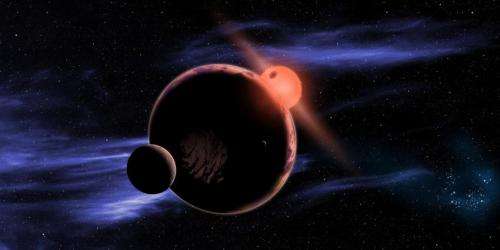Red dwarf stars might be best places to discover alien life

Red dwarfs are the most common type of star in the universe, and nearly every one of these stars may have a planet located in its habitable zone where life has the best chance of existing, a new study concludes.
This discovery may increase the chances that alien life could exist elsewhere in the cosmos, researchers say. They detailed their findings in the International Journal of Astrobiology.
Red dwarfs, also known as M dwarf stars, are up to 50 times dimmer than the Sun and are just 10 to 20 percent as massive. They make up to 70 percent of the stars in the universe.
The fact that red dwarfs are so common has made scientists wonder if they might be the best places to discover alien life. Astronomers are discovering more and more planets around red dwarfs, and recent findings from NASA's Kepler space observatory reveal that at least half of these stars host rocky planets that are one-half to four times the mass of Earth. All in all, planets about the size of Earth seem plentiful in the universe, as do other worlds that are smaller than most gas giants, on the order of Neptune (which is 17 times the mass of Earth). Why such worlds are abundant is a mystery.
A leading theory in planetary formation suggests that as embryonic planets develop in the disks of gas and dust surrounding newborn stars, these nascent planets migrate inward as the matter in these proto-planetary disks erodes their orbits. However, migration models suggest Neptune-size planets should be rarer than they actually are.
Instead, some researchers have suggested these relatively low-mass planets may assemble in situ—that is, they are born and stay in much the same places around their stars their entire lives, with little to no migration toward or away from their stars. Study author Brad Hansen, an astrophysicist at the University of California at Los Angeles, used computer models of in situ planetary formation to see how often red dwarfs might develop Earth-sized worlds, and where these planets might orbit around the stars.
In his computer simulations, Hansen modeled red dwarfs half the mass of the Sun, with proto-planetary disks extending from 0.05 AU to 1 AU (one astronomical unit is the average distance from the Sun to the Earth) from the stars. The disks contained an amount of gas and dust equal to six times the mass of Earth. He then looked at how many planets developed after 10 million years.
Of particular interest to Hansen were the so-called habitable zones of these stars, the areas where planets are potentially warm enough to sustain liquid water—and potentially life—on their surfaces. Red dwarfs are relatively cold stars, which means their habitable zones are closer than Mercury is to the Sun—just 0.1 to 0.2 (AU.
Hansen found most of the resulting planetary systems comprise between four and six surviving planets inside 0.5 AU, although the largest number went as high as 10. In addition, the red dwarfs usually possessed one or two planets within their habitable zones, which extended from 0.23 to 0.44 AU.
"A high frequency of potentially habitable planets makes it more likely that we could actually find one that is habitable," Hansen said.
Moreover, Hansen also found that planets in the habitable zones of red dwarf stars could accumulate significant amounts of water. In fact, each could possess roughly 25 times more water than Earth has as a whole. All in all, he noted these results "broadly support the notion that habitable planets are plentiful around M dwarfs in the solar neighborhood."
More information: International Journal of Astrobiology, journals.cambridge.org/action/ … Id=S1473550414000159
Journal information: International Journal of Astrobiology
Source: Astrobio.net
This story is republished courtesy of NASA's Astrobiology Magazine. Explore the Earth and beyond at www.astrobio.net .





















